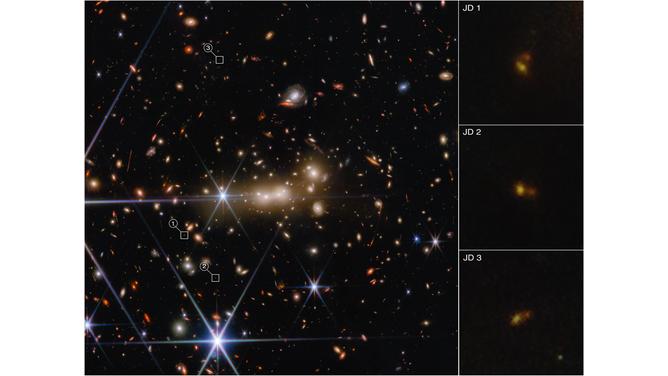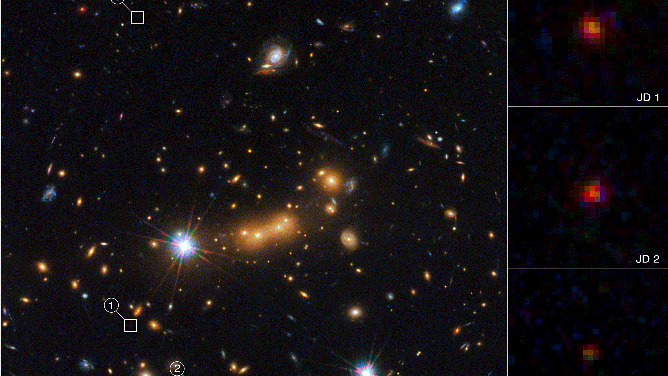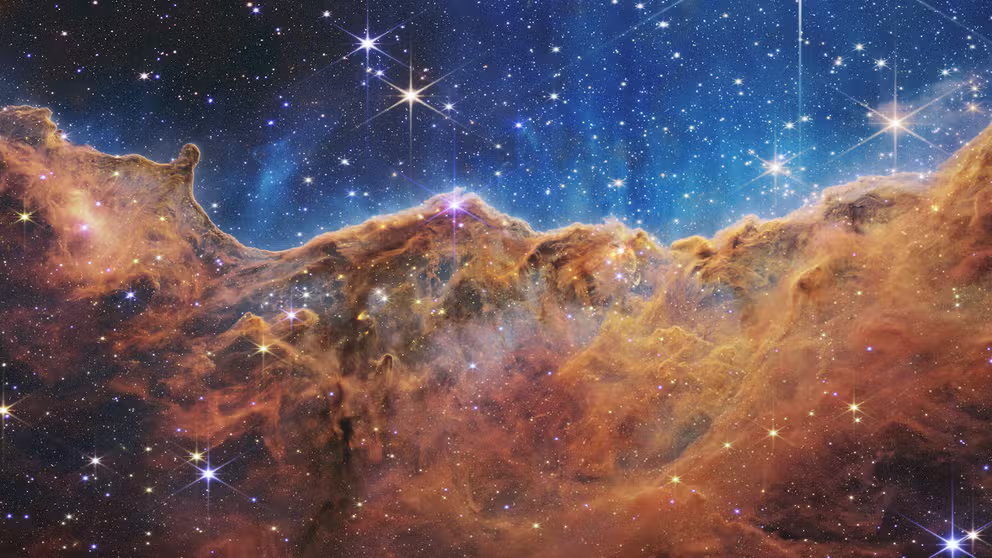First discovered by Hubble, JWST gives early universe galaxy new sparkle
The reason astronomers are so excited about those little smudges in the new JWST image is that when the system was first discovered 10 years ago using the Hubble Space Telescope, the object appeared as "just this pale, red dot."

The massive gravity of galaxy cluster MACS0647 acts as a cosmic lens to bend and magnify light from the more distant MACS0647-JD system. It also triply lensed the JD system, causing its image to appear in three separate locations. These images, which are highlighted with white boxes, are marked JD1, JD2, and JD3; zoomed-in views are shown in the panels at right. (Credits: SCIENCE: NASA, ESA, CSA, Dan Coe (STScI), Rebecca Larson (UT), Yu-Yang Hsiao (JHU) IMAGE PROCESSING: Alyssa Pagan (STScI))
The James Webb Space Telescope is giving us another "glow up" of a galaxy that once appeared as just a pale red dot to the Hubble Space Telescope 10 years ago.
NASA and its partners released the latest image taken by the most powerful telescope on Wednesday. It uses galaxy cluster MACS0647 to bend and magnify light from a more distant galaxy called MACS0647-JD, dating back almost to the big bang.
James Webb Space Telescope's NIRCam instrument triply lensed the JD system causing the galaxy candidate to appear in three separate images. NASA has labeled those JD 1, 2, and 3. The dots in the background are also galaxies.
JWST CAPTURES STUNNING PHOTO REVEALING ‘KALEIDOSCOPE OF COLOR’ IN PILLARS OF CREATION
According to the Space Telescope Science Institute, the closer galaxy cluster is 5.6 billion light-years away, and the farther system is about 13.3 billion light-years from Earth.
Incredible images from James Webb show the universe like never before
As the world's premier space science observatory, the James Webb Space Telescope is giving us glimpses into distant worlds like never before.
The reason astronomers are so excited about those little smudges highlighted as JD 1, 2 and 3 in the image above is that when astronomers first discovered the system 10 years ago using the Hubble Space Telescope, the object appeared as "just this pale, red dot."
Dan Coe, the astronomer who discovered MACS0647-JD in 2012, told NASA: "We could tell it was really small, just a tiny galaxy in the first 400 million years of the universe. Now we look with Webb, and we’re able to resolve TWO objects!"
HOW TO MOVE A $10 BILLION SPACE TELESCOPE 5,800 MILES, AVOID PIRATES AND SEE BACK INTO THE COSMOS
Below is a comparison between the Hubble Space Telescope images in 2012 and JWST's new images taken this year of the JD system.

A comparison between the Hubble Space Telescope images of MACS0647-JD from 2012 and the 2022 images from the James Webb Space Telescope. Note that MACS0647-JD appears as a faint, red dot in the Hubble image, but Webb reveals much more detail. (Image Credits: SCIENCE: NASA, ESA, CSA, STScI, and Tiger Hsiao (Johns Hopkins University) IMAGE PROCESSING: Alyssa Pagan (STScI)
Like all things in space science, this discovery has led to more questions. Coe said scientists are still investigating whether the two objects are separate galaxies or possibly two clumps of stars.
WEBB CAPTURES JUPITER'S SWIRLING WEATHER, COLORFUL AURORAS AND RINGS
"We don’t know, but these are the questions that Webb is designed to help us answer," said Coe, with the European Space Agency and Johns Hopkins University.
Astronomer Rebecca Larson with the University of Texas at Austin said that until now, they haven't been able to study galaxies from the early universe in detail, and this new image isn't even the best Webb can do.
"This is not a deep field. This is not a long exposure. We haven’t even really tried to use this telescope to look at one spot for a long time," Larson told NASA. "This is just the beginning!"
The team has follow-up observations of MACS0647-JD with Webb planned for early next year.
